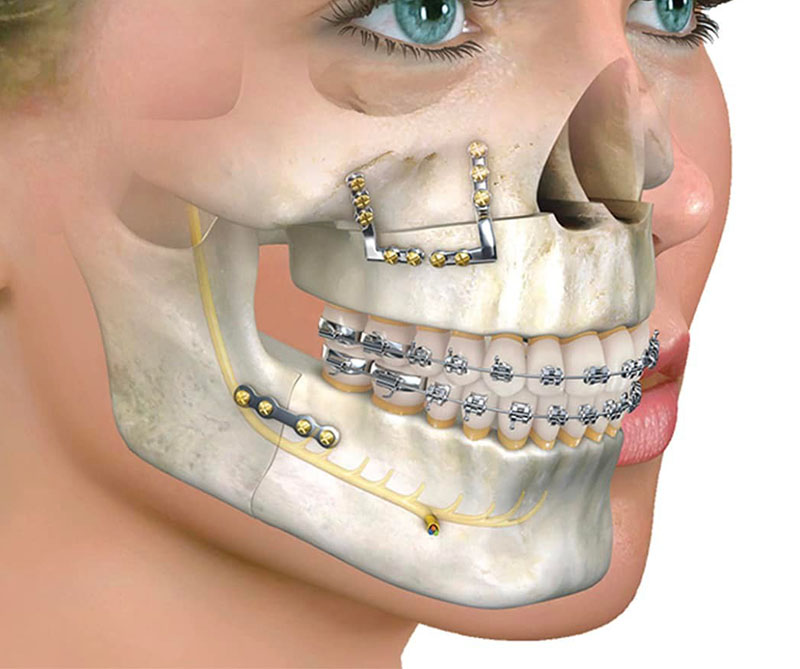
The jaw is one of the most complex joints in the body, and when a single component of the jaw isn’t working properly, patients may develop symptoms like discomfort or locking or popping of the jaw. The patient may also be dissatisfied with the jaw’s effects on the smile’s appearance.
Orthognathic surgery can help to correct jaw defects in such cases. This category of intervention includes multiple procedures targeting the different components of the jaw. Orthognathic surgery ranges in terms of complexity, as well.
If you have experienced jaw issues, we welcome you to schedule an evaluation to see if orthognathic surgery may help. Call our office to schedule an appointment.
Which jaw problems might require orthognathic surgery?
Orthognathic surgery may target the following issues in patients:
- Malocclusions (open bites, underbites, overbites)
- Effects of facial trauma
- Obstructive sleep apnea
- Temporomandibular joint (TMJ) disorder
- Congenital defects
These issues can affect both the aesthetics of the smile and the functioning of the jaw. They may cause discomfort for patients or affect their ability to chew or speak. Orthognathic surgery can give patients symptom relief and improve their self-confidence.
Orthognathic surgery may be performed in conjunction with orthodontic treatment or may be pursued when orthodontic treatment alone has failed to address the problem.
How does orthognathic surgery correct jaw problems?
The type of issue being addressed by oral surgery will determine the approach used by the Pinnacle Oral Surgery team. The process begins with a comprehensive evaluation of your case involving various types of imaging, such as x-rays and CAT scans.
Orthognathic surgery may remove excess bone tissue or supplement or reshape the jawbone in certain places if necessary. It may also restore the jaw’s structure after an injury or repair damage to a component that is contributing to TMJ pain.
During the surgery, devices such as wires, screws or plates may be inserted into the jaw to stabilize it.
The amount of time needed for orthognathic surgery can range from an hour to several hours, depending on the complexity of the case.
How do I prepare for orthognathic surgery?
In many ways, preparing for orthognathic surgery is similar to preparing for other types of oral surgery. For example, you may want to plan for your post-operative days by buying soft foods that will require minimal chewing as you heal.
You may also want to visit your pharmacy in advance to get any medications, such as antibiotics or painkillers, that have been prescribed for you, in addition to supplies that you will need for self-care.
Patients who choose to have sedation for their orthognathic surgery will need to take steps in advance to receive that sedation. If you are having IV sedation, you’ll need to fast for several hours prior to your appointment.
We want you to be as prepared as possible for your orthognathic surgery, so we encourage you to ask any questions that you may have in advance of the procedure.
What should I expect as I heal after my orthognathic surgery?
Depending on the nature of your procedure, you may be able to resume normal activities within a matter of days. Patients who have undergone more extensive surgery will need to plan for a week or two off before returning to work or school.
You may have some mild swelling or discomfort at first after your surgery. However, these symptoms should dissipate within a few days. If they persist beyond that time, contact our office as soon as possible to follow up.
Keeping your mouth clean is essential to reduce the risk of infection after orthognathic surgery. Follow your oral surgeon’s instructions to make sure that you are cleaning your mouth safely and thoroughly when you return home.
FAQs about Orthognathic Surgery
Orthognathic surgery is a category of corrective jaw surgeries that address issues such as malocclusions, damaged jaw components or the effects of facial trauma. Orthognathic surgery may remove bone, reset bone, add bone or reshape bone as needed to achieve the desired treatment goals.
Patients can expect to experience some level of discomfort following orthognathic surgery, but it typically can be managed with over-the-counter or prescription painkillers. The discomfort is temporary and should resolve within a few days. Notably, discomfort may be more significant and longer lasting in patients who had more involved procedures.
Dental or medical insurance may provide some coverage for orthognathic surgery. Our experienced billing staff will investigate your insurance coverage and inform you of any anticipated out-of-pocket costs.
The initial recovery period following orthognathic surgery can last anywhere from a few days to a few weeks, depending on the degree of surgery performed. Healing is an ongoing process, and it may take the patient several weeks to heal fully after the procedure. Because orthognathic surgery is so individualized, it’s best to ask your oral surgeon what to expect for recovery in your specific case.
